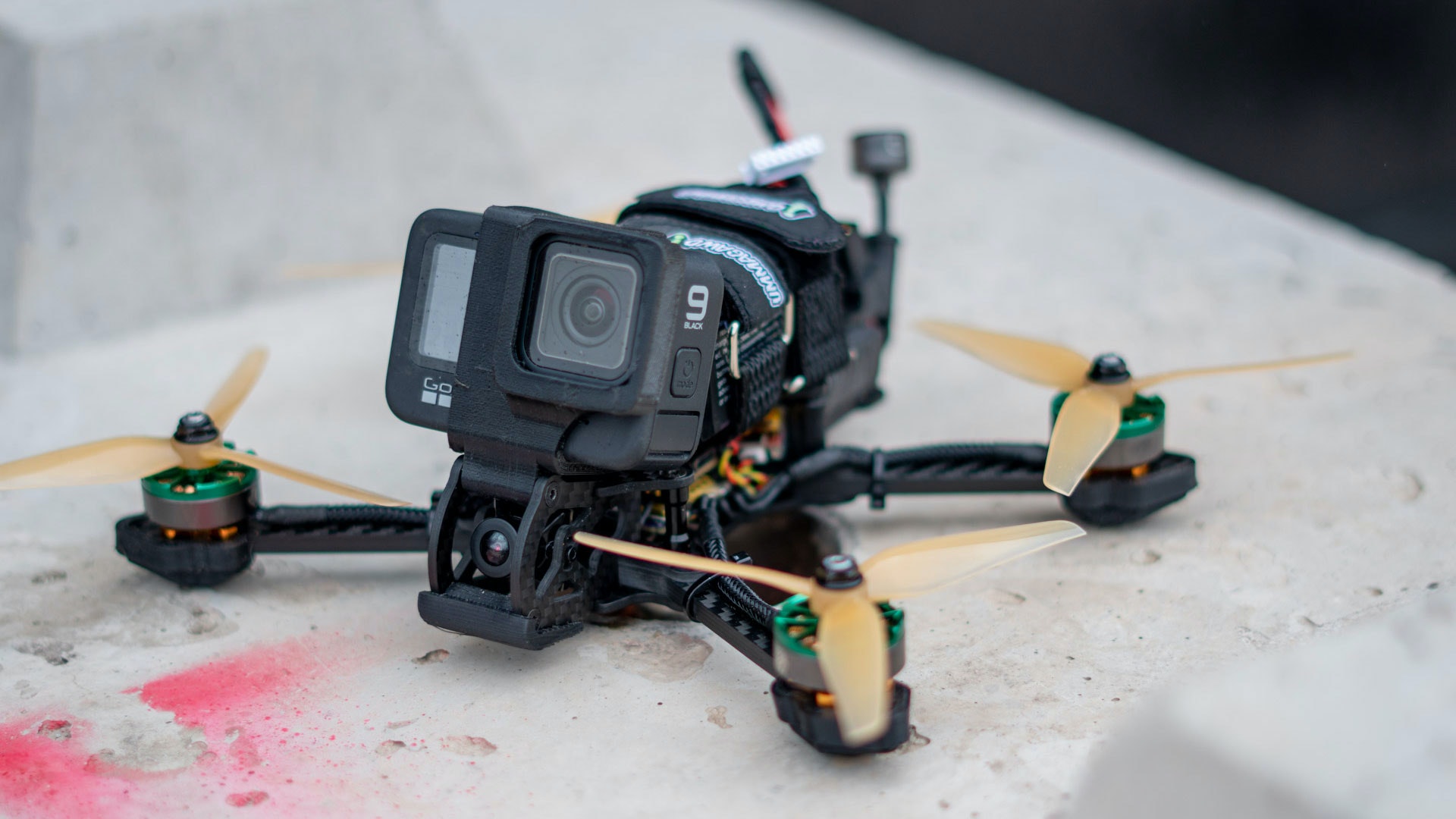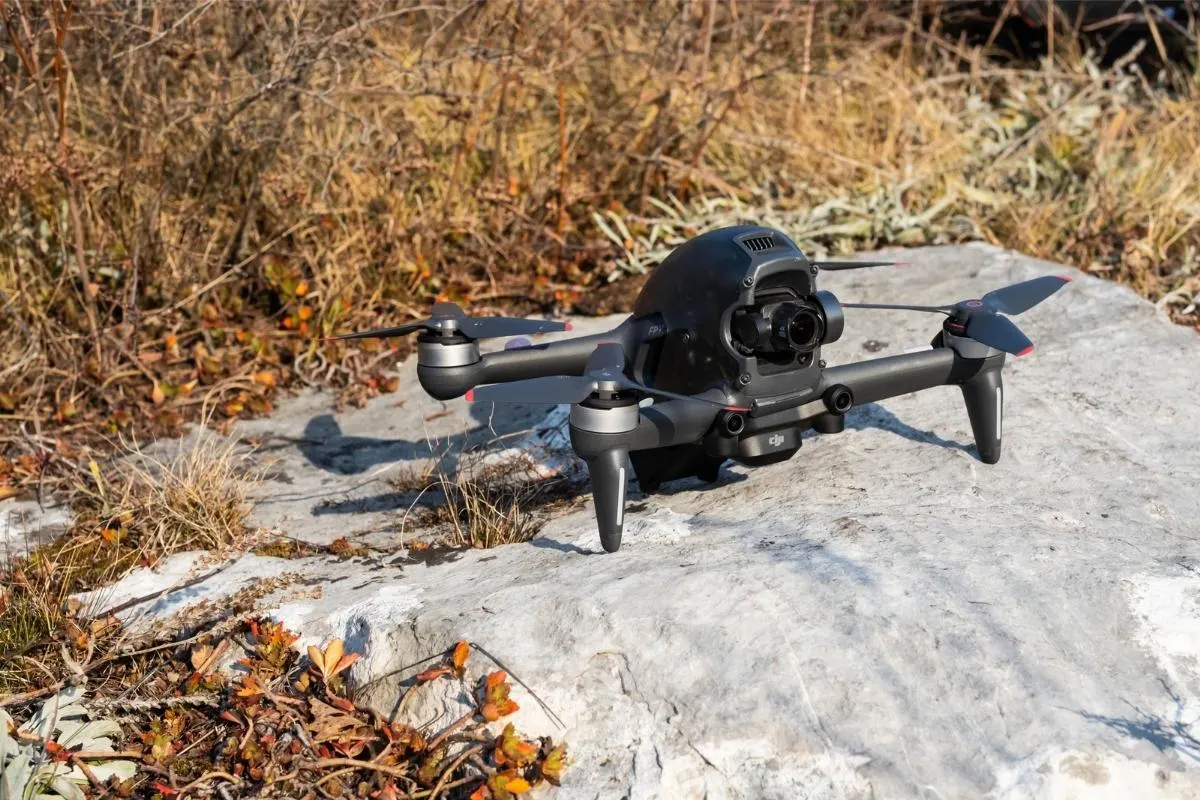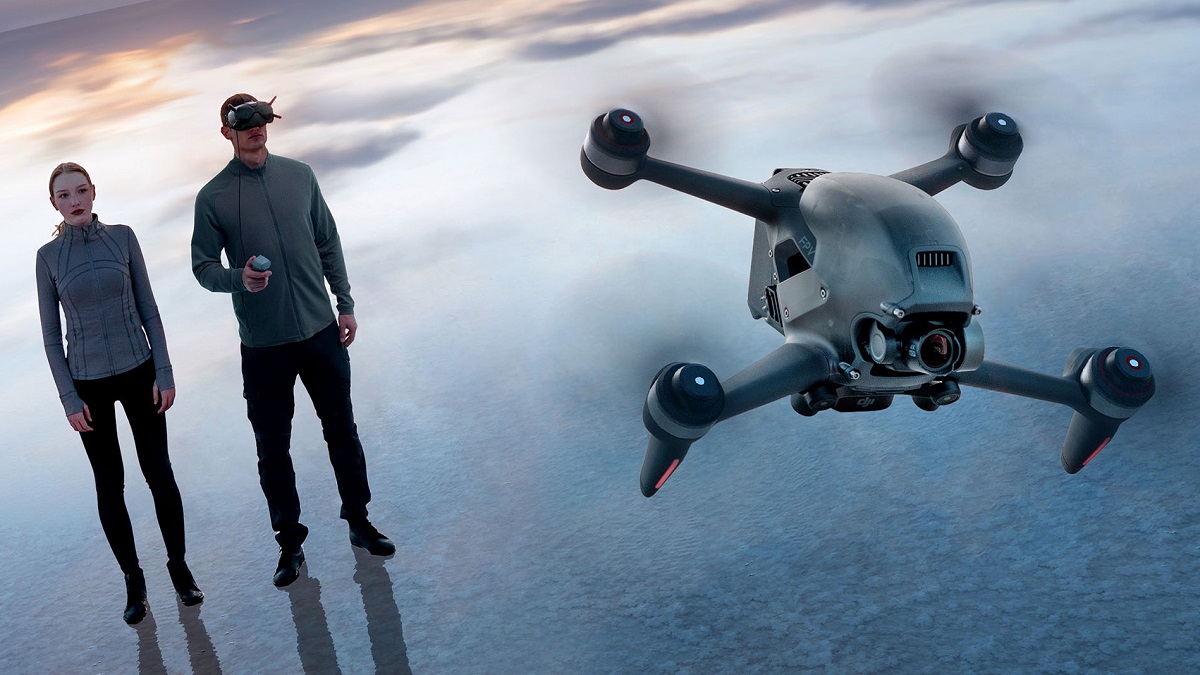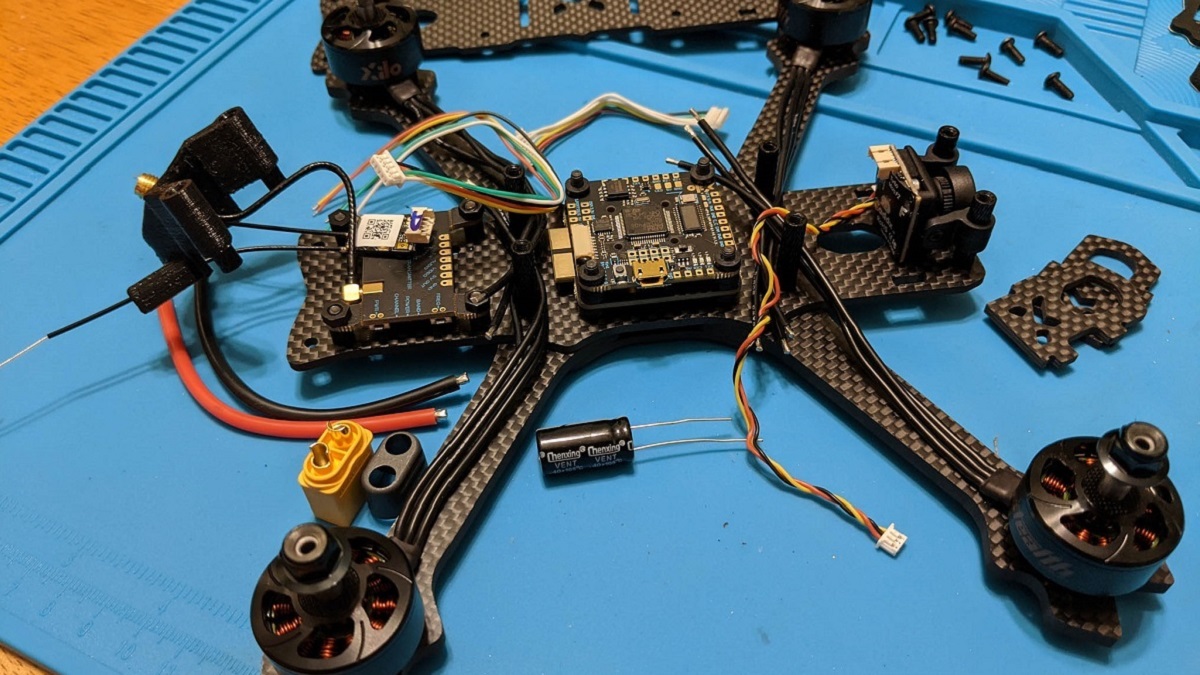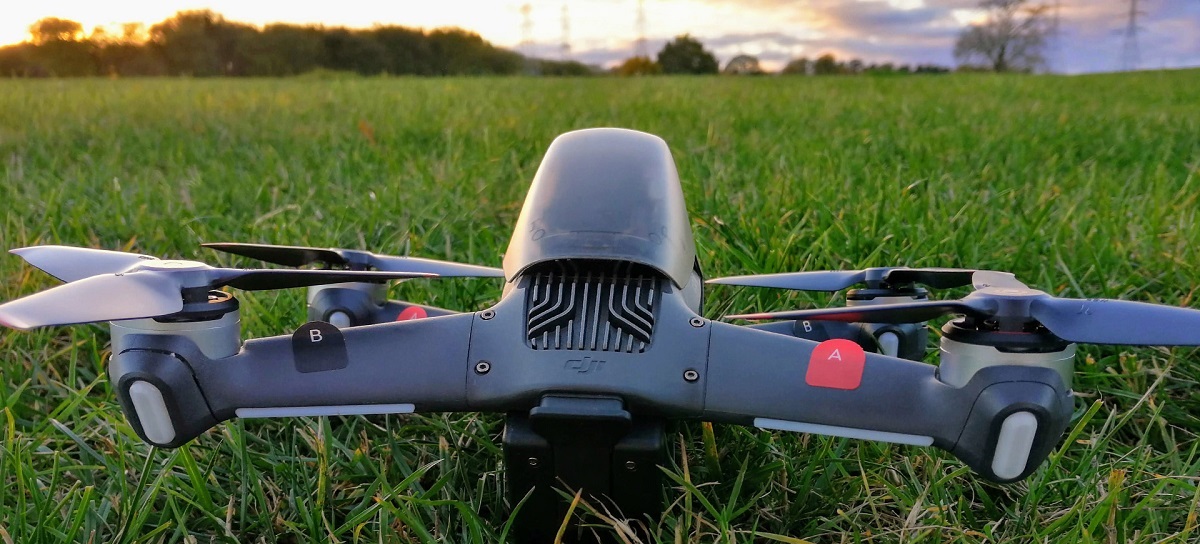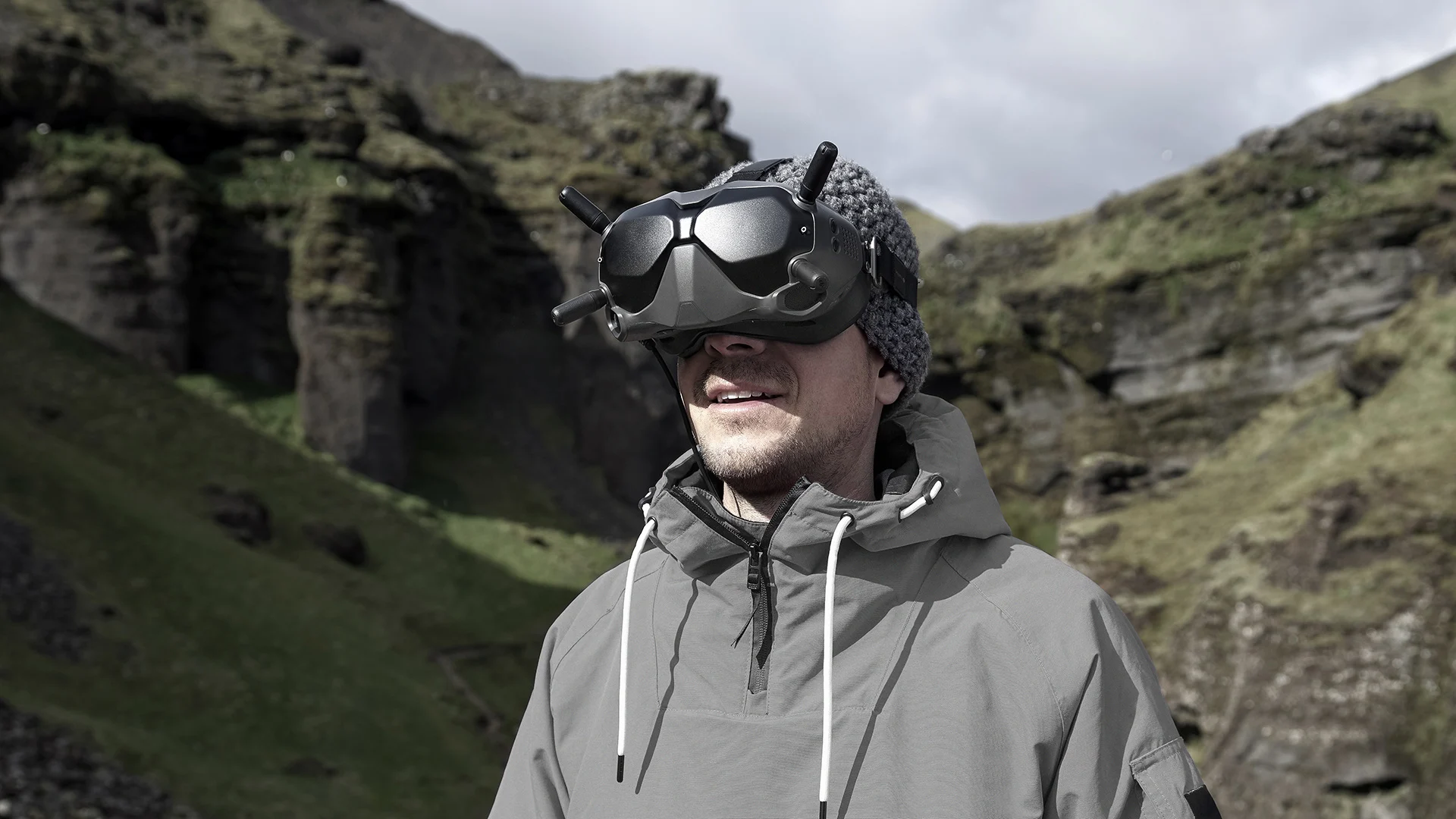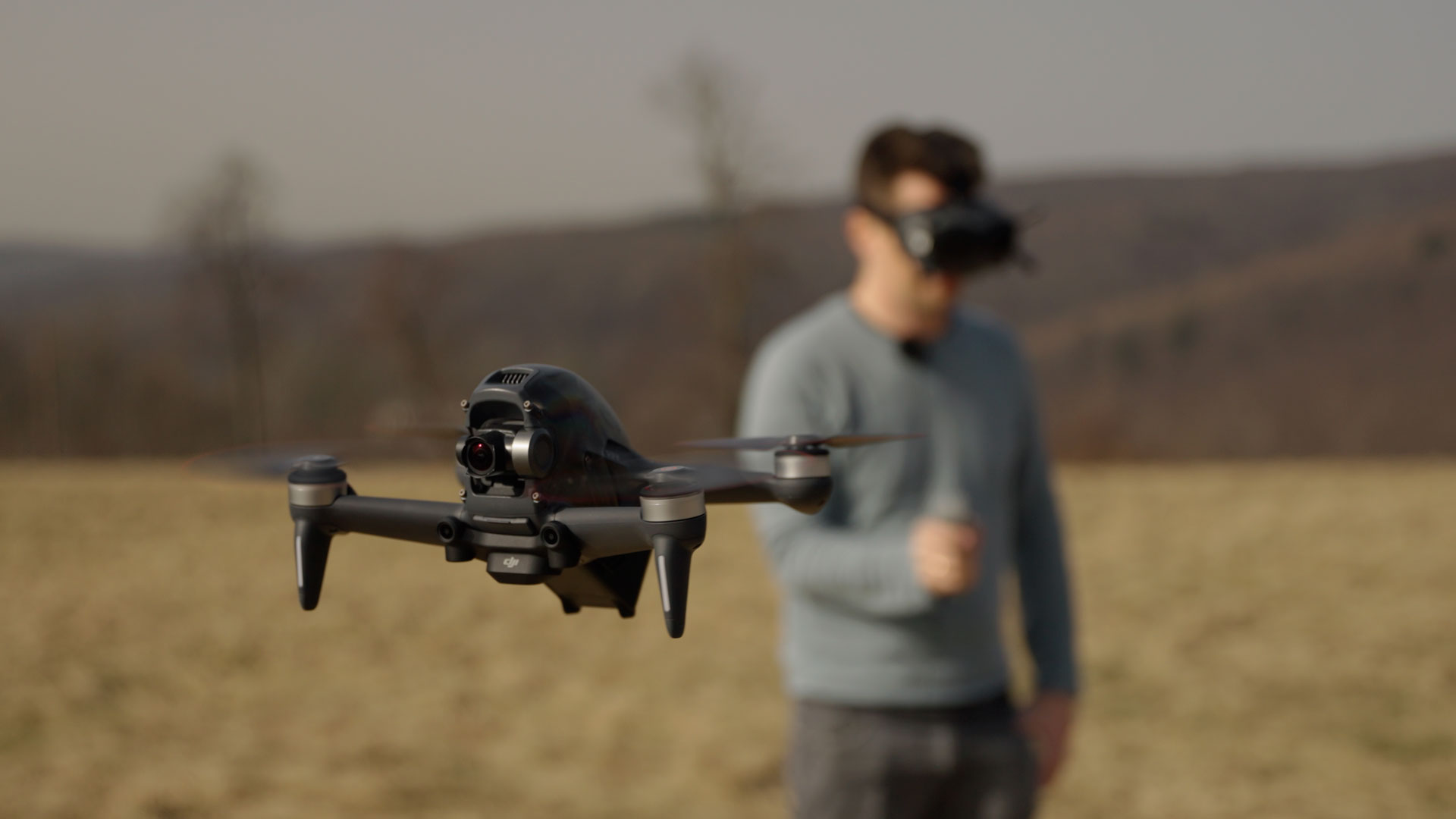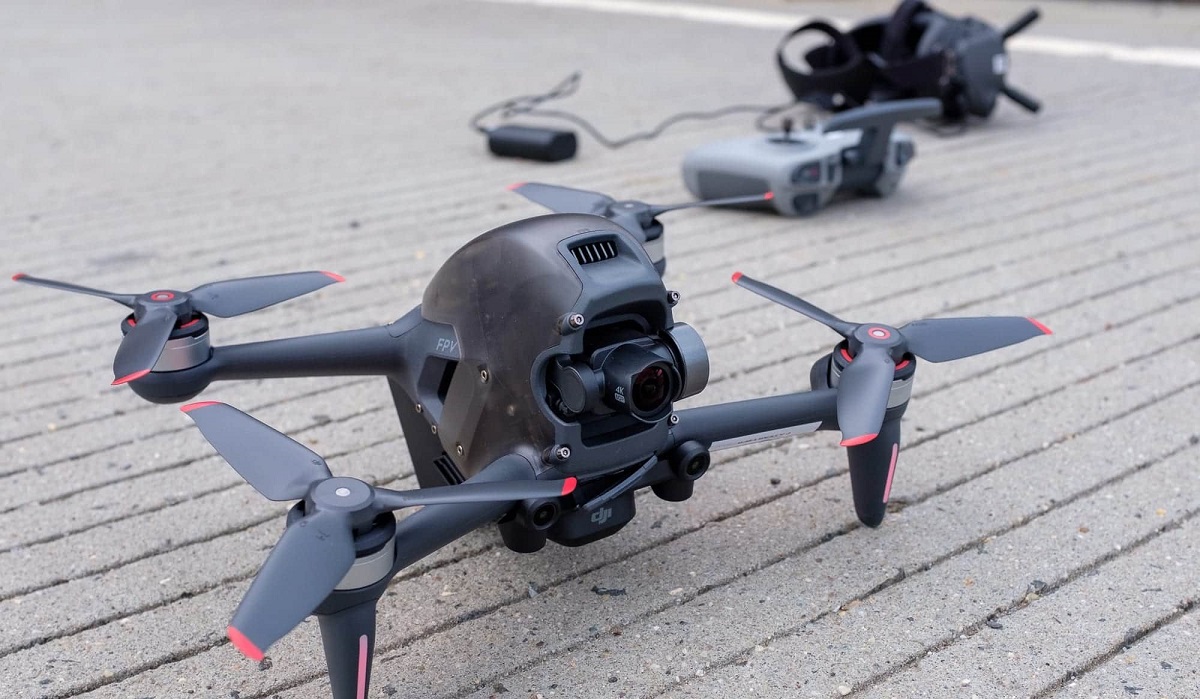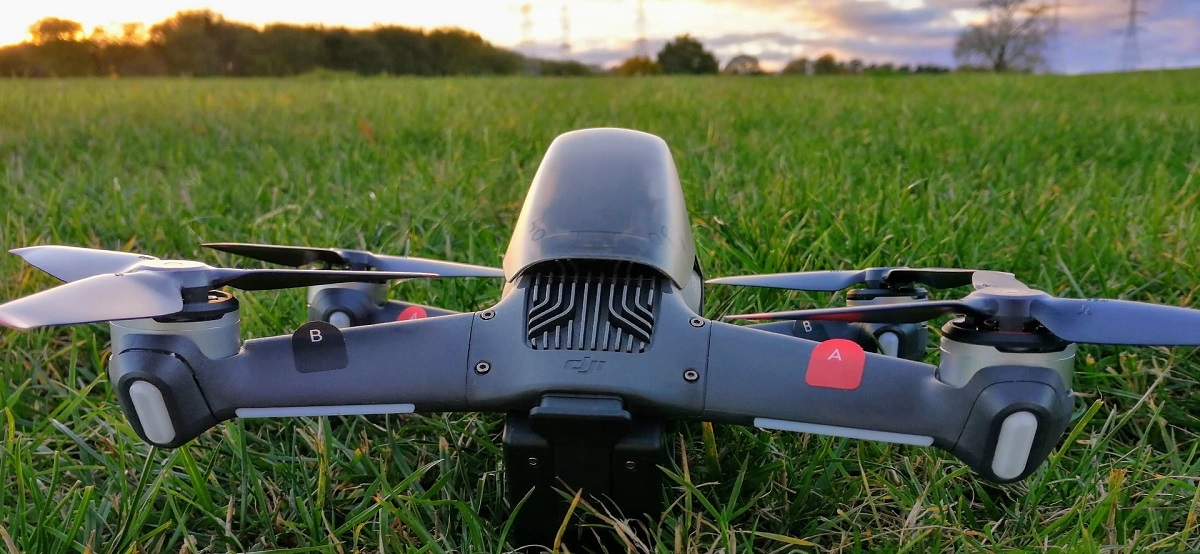Introduction
Welcome to the exciting world of FPV (First Person View) drone flying! If you’re looking to experience the thrill of soaring through the sky from the comfort of your own cockpit, then flying a FPV drone is the perfect hobby for you. FPV drones provide an immersive and exhilarating experience, allowing you to see the world from a whole new perspective.
With an FPV drone, you can capture breathtaking aerial footage, explore remote locations, and even participate in exhilarating races. But, like any skill, flying a FPV drone requires practice, patience, and knowledge. In this guide, we will take you through everything you need to know to start your journey as an FPV drone pilot.
From choosing the right drone to understanding the controls, mastering basic maneuvers to exploring different flight modes, we will cover it all. We’ll also provide you with tips for capturing epic footage and showcase advanced techniques and tricks for those looking to take their skills to the next level.
But before we dive into the world of FPV drone flying, it’s important to mention that safety should always be the top priority. Flying a FPV drone comes with certain risks, so it’s crucial to follow the rules and guidelines set by regulatory authorities and exercise caution at all times.
So, whether you’re a beginner hoping to take your first flight or an experienced pilot looking to sharpen your skills, this guide is here to help. Let’s embark on this exciting journey together and discover the endless possibilities that come with flying a FPV drone!
Why Fly a FPV Drone?
Flying a FPV drone offers a unique and thrilling experience that is unmatched by any other hobby. Here are several compelling reasons why you should consider taking up FPV drone flying:
- Immersive Experience: FPV drones allow you to see the world from a whole new perspective. With live video transmission to your goggles or monitor, you can experience the thrill of flying as if you were right in the cockpit. You’ll feel a sense of freedom and excitement as you navigate through the air.
- Breathtaking Aerial Footage: If you have a passion for photography or videography, FPV drones provide an excellent platform to capture stunning aerial shots. With their maneuverability and high-quality cameras, you can create cinematic masterpieces from above, giving a unique perspective to your photos and videos.
- Exploration and Adventure: FPV drones open up a world of exploration and adventure. You can fly in places that were once inaccessible and discover hidden landscapes, scenic locations, and breathtaking views. Whether you’re exploring nature, urban environments, or historical landmarks, FPV drone flying offers endless opportunities for discovery.
- Racing and Competition: If you’re a thrill-seeker, FPV drone racing is a high-intensity sport that will get your adrenaline pumping. Compete against other pilots in races filled with hairpin turns, obstacles, and high speeds. It combines the excitement of flying with the competitiveness of a sport, making it an exhilarating experience like no other.
- Skill Development: Flying a FPV drone requires a set of skills that can be honed over time. From understanding flight dynamics to mastering different flight modes, FPV drone flying is a continuous learning process. It challenges your hand-eye coordination, spatial awareness, and problem-solving abilities, helping you develop skills that can be valuable in other aspects of life.
- Community and Connection: FPV drone flying has a vibrant and supportive community. Joining this community allows you to connect with like-minded individuals who share your passion for flying. You can attend meetups, races, and events to learn from experienced pilots, exchange tips and tricks, and form lasting friendships.
So whether you’re seeking an immersive experience, a creative outlet, a sense of adventure, or a competitive edge, flying a FPV drone offers something for everyone. Strap on your goggles and get ready to embark on an exciting journey filled with endless possibilities!
Getting Started
Before taking to the skies with your FPV drone, it’s important to ensure you have everything you need and understand the basics. Here are the key steps to get started:
- Research and Education: Begin by educating yourself about FPV drone flying. Read articles, watch tutorial videos, and join online forums to gather information and learn from experienced pilots. Familiarize yourself with the rules and regulations set by aviation authorities to ensure safe and legal flying.
- Invest in Quality Equipment: To enjoy a smooth and successful FPV drone flying experience, invest in a reliable and well-built drone. Look for a drone that suits your skill level and has good reviews. Consider features like flight time, camera quality, and durability. Don’t forget to purchase spare batteries, propellers, and a good-quality transmitter/receiver system.
- Register and Obtain Necessary Licenses: Depending on your country’s regulations, you may need to register your drone and obtain specific licenses or certifications. Check with your local aviation authority for the specific requirements in your area. Compliance with these rules ensures safe and responsible flying.
- Understand Your Drone: Take the time to thoroughly read and understand the user manual that comes with your drone. This will help you get familiar with its features, controls, and flight modes. Be aware of any limitations or specific requirements your drone may have, such as calibration or firmware updates.
- Find a Suitable Flying Location: Look for a spacious and open area with minimal obstructions to practice flying your drone. Parks, open fields, or designated flying sites are ideal for beginners. Ensure that you have permission to fly in the chosen location and respect any restricted areas, including those near airports or government facilities.
- Practice Safe Flying Techniques: Safety is paramount in FPV drone flying. Always keep your drone within line of sight, and maintain a safe distance from people, buildings, and wildlife. Start with low-altitude flights and gradually increase as you gain more confidence. Pay attention to weather conditions and avoid flying in strong winds or rain.
- Join a Community or Seek Guidance: Consider joining a local FPV drone flying community or online forums where you can connect with experienced pilots. They can provide valuable advice, tips, and troubleshoot any issues you may encounter along the way. Learning from others can accelerate your progress and enhance your flying skills.
By following these steps, you will be well-prepared to start your journey as an FPV drone pilot. Remember, practice makes perfect, so take your time to master the basics before attempting more advanced maneuvers. Be patient, stay safe, and enjoy the thrilling experience of flying FPV drones!
Choosing the Right FPV Drone
Choosing the right FPV drone is crucial to ensuring an enjoyable and successful flying experience. With numerous options available in the market, it can be overwhelming to make the right choice. Consider the following factors when selecting your FPV drone:
- Skill Level: Assess your skill level as a pilot. If you are a beginner, opt for a drone that is specifically designed for beginners and offers stability and ease of control. More advanced pilots can look for drones with higher performance capabilities and advanced features.
- Intended Use: Determine your primary use for the FPV drone. Are you interested in aerial photography and videography? Do you want to participate in races? Different drones are designed for specific purposes, so choose one that aligns with your goals.
- Flight Time: Consider the flight time of the drone. This refers to the duration the drone can stay in the air on a single battery charge. Longer flight times will allow you to capture more footage or enjoy longer flying sessions before needing to recharge.
- Camera Quality: If capturing high-quality aerial footage is your priority, check the camera specifications of the drone. Look for drones with built-in stabilized cameras, adjustable angles, and high-resolution capabilities. Some drones may also have features like FPV video transmission, allowing real-time video viewing on your goggles or mobile device.
- Range and Signal Transmission: Consider the range and signal transmission capabilities of the drone. A longer range allows you to explore a larger area and fly further distances without losing control or video feed. Look for drones that offer reliable and stable signal transmission for a seamless flying experience.
- Build Quality and Durability: Assess the build quality and durability of the drone, especially if you are a beginner. Look for drones made from sturdy materials that can withstand crashes and rough handling. Some drones offer replaceable parts and easy-to-fix designs, which can save you money in case of accidents.
- Budget: Determine your budget range for the FPV drone. Prices can vary significantly, depending on the features and capabilities of the drone. Set a realistic budget and look for drones that offer the best value within your price range.
Researching and reading reviews from reliable sources can provide you with valuable insights into the performance and user experience of different FPV drones. Take the time to compare specifications, read user feedback, and consider your own requirements to make an informed decision.
Remember, choosing the right FPV drone is a personal decision, and what works for someone else may not necessarily work for you. Take your time, weigh your options, and select a drone that matches your skill level and flying aspirations. A well-chosen FPV drone will enhance your flying experience and open up a world of possibilities in the thrilling realm of FPV drone flying!
Assembling Your FPV Drone
Assembling your FPV drone is an exciting and important step before you can take it to the skies. While the specifics may vary depending on the drone model you have chosen, here are some general guidelines to help you with the assembly process:
- Read the Manual: Start by carefully reading the user manual provided by the drone manufacturer. The manual will provide step-by-step instructions specific to your drone model, including the order of assembly and any special considerations.
- Prepare Your Workspace: Find a clean, well-lit, and clutter-free workspace to assemble your drone. Having ample space and good lighting will make the process easier and help you avoid losing small components.
- Identify the Components: Lay out all the components included with your drone kit and familiarize yourself with each part. Identify the frame, flight controller, motors, ESCs (Electronic Speed Controllers), propellers, and any other hardware that needs to be assembled.
- Mount the Motors: Attach the motors to the designated positions on the drone frame. Each motor should be securely fastened using the provided screws. Pay attention to the motor rotation direction indicated in the manual or on the motors themselves.
- Connect the ESCs: Connect the ESCs to the flight controller according to the wiring diagram provided. Ensure that each ESC is connected to its corresponding motor. Double-check the connections to ensure they are secure and properly soldered if required.
- Mount the Flight Controller: Mount the flight controller onto the drone frame using the included vibration-damping materials or standoffs. Follow the manufacturer’s instructions for the correct orientation and attachment method.
- Attach the Propellers: Attach the propellers to each motor’s shaft, making sure they are properly aligned and secured. Follow the indicated rotation direction for each propeller, typically labeled as “CW” (clockwise) or “CCW” (counterclockwise).
- Install and Secure the FPV Camera: Install the FPV camera onto the drone frame, adjusting it for optimal viewing angles. Ensure that the camera is securely attached, and the lens is protected from damage during flight.
- Connect and Secure the Antennas: Connect the FPV transmitter and receiver antennas to their respective connectors on the drone, making sure they are securely mounted to prevent accidental disconnection during flight.
- Double-Check all Connections: Before powering up the drone for the first time, carefully inspect all connections, wires, and components to ensure they are secure and properly connected. Use zip ties or electrical tape to organize and secure any loose wires.
It is highly recommended to follow the manufacturer’s instructions and guidelines provided in the manual for your specific drone model. If you face any difficulties during the assembly process, refer to online resources or seek guidance from the drone community to ensure a successful assembly.
Once your FPV drone is assembled, perform a thorough inspection, check for any loose connections, and conduct a preliminary test to verify that everything is functioning as expected. Taking the time to properly assemble your FPV drone will not only ensure its performance but also contribute to a safer and more enjoyable flying experience.
Understanding the Controls
Before taking your FPV drone to the skies, it’s vital to understand the various controls that govern its movements. Familiarizing yourself with these controls will help you maneuver and navigate your drone with precision and confidence. Here are the primary controls you need to understand:
- Throttle: The throttle control manages the drone’s vertical movement or altitude. By increasing the throttle, the drone ascends, while decreasing the throttle causes it to descend. Practice gradual adjustments to maintain stable flight and avoid sudden altitude changes.
- Pitch, Roll, and Yaw: These controls are responsible for the drone’s movements in different directions. Pitch controls the forward and backward movements, roll controls the left and right movements, and yaw controls the rotation or directional changes. These controls affect the drone’s orientation and allow you to navigate through different flight paths.
- Transmitter Sticks: The transmitter or remote control is equipped with two sticks: the left stick and the right stick. The left stick controls throttle and yaw, while the right stick controls pitch and roll. Moving these sticks in different directions correspondingly adjusts the drone’s movements.
- Trim Buttons: Trim buttons are small buttons or switches present on the transmitter that allow you to fine-tune the drone’s performance. These buttons help in calibrating the drone’s stability and rectifying any minor imbalances or drifts during flight. Adjust the trim buttons as needed to achieve a well-balanced and stable flight.
- Flight Modes: Many FPV drones offer different flight modes, such as stabilized mode, acrobatic mode, or GPS mode. Each mode has its own characteristics and limitations. Understanding and selecting the appropriate flight mode for your flying objectives is essential. Stabilized mode is recommended for beginners, as it provides a more stable and predictable flight experience, while acrobatic mode offers more agility and freedom for advanced maneuvers.
- Arming and Disarming: Arming refers to the process of powering on the drone’s motors, allowing it to take off. Disarming, on the other hand, is the process of turning off the motor after landing. Follow the specific arming and disarming procedures outlined in your drone’s manual to ensure safe and controlled operation.
- Flight Controller Configurations: Some advanced FPV drones may have configurable flight controllers that allow you to adjust settings such as sensitivity, rates, and expo. These settings can be tailored to your flying style and preferences, enabling you to fine-tune the drone’s responsiveness and performance.
- Practice and Repetition: Mastering the controls of your FPV drone requires practice and repetition. Start with basic maneuvers such as hovering, gentle turns, and altitude changes. As you gain confidence and proficiency, gradually progress to more advanced maneuvers like flips, rolls, and precision flying.
It’s important to note that the specific controls and their functionalities may vary slightly between different drone models. Therefore, always refer to the user manual provided by the manufacturer for detailed information and instructions specific to your drone.
Understanding and practicing the controls of your FPV drone will allow you to fly with confidence and precision. Take the time to familiarize yourself with each control, practice regularly, and gradually increase the complexity of your flights. With patience and dedication, you’ll soon have full command over your drone, enabling you to capture breathtaking aerial footage and navigate through the skies with ease.
Pre-flight Checklist
Before every FPV drone flight, it’s essential to perform a pre-flight checklist to ensure the safety and proper functioning of your drone. By following a pre-flight checklist, you can minimize the risk of accidents and maximize your flying experience. Here are the key items to include in your pre-flight checklist:
- Check Battery Levels: Ensure that the drone’s battery and the transmitter’s battery are adequately charged. Low battery levels can affect flight performance and lead to unexpected power loss during flight. If necessary, charge the batteries to their full capacity before the flight.
- Inspect the Drone: Thoroughly inspect the physical condition of your drone. Check for any signs of damage, loose parts, or wear and tear that could pose a safety risk. Pay attention to the propellers, frame, and wiring. If you notice any issues or defects, address them before the flight.
- Calibrate Sensors: Some drones require sensor calibration before flying. Follow the manufacturer’s instructions to calibrate the drone’s compass and gyroscope, ensuring accurate readings and stable flight performance. Failure to calibrate the sensors can cause erratic behavior and loss of control.
- Clear Flying Area: Ensure that the flying area is clear of any obstacles or hazards that may interfere with the drone’s flight. Watch out for trees, buildings, power lines, or other structures that could pose a risk. Clear the area of any debris or loose objects that could be picked up by the drone’s propellers during flight.
- Confirm Signal Connectivity: Check the signal connectivity between the drone and the remote control. Ensure that the transmitter and receiver are properly paired and that there are no connectivity issues. A stable signal connection is crucial for maintaining control and receiving real-time flight information.
- Install Memory Card: If your drone has a camera for capturing footage, make sure a memory card is inserted and functioning correctly. Verify that there is enough storage space on the card for recording the desired footage. An insufficient or faulty memory card may result in the loss of valuable footage.
- Set Home Point (GPS-enabled drones): For GPS-enabled drones, set the home point by initializing the GPS lock. This ensures that the drone can return to its takeoff location in case of an emergency or signal loss. Confirm that the home point is properly set before taking off.
- Check Weather Conditions: Assess the weather conditions before the flight. Avoid flying in high winds, rain, or extreme temperatures that may adversely affect the drone’s performance or pose a safety risk. Check the forecast for any potential changes or severe weather warnings that could impact the flight.
- Review Local Regulations: Familiarize yourself with the local regulations and rules for flying drones in your area. Ensure compliance with any restrictions, airspace limitations, or permit requirements. Ignoring regulations can lead to legal consequences and compromise safety.
Going through this pre-flight checklist helps to mitigate risks and ensures that your drone is in optimal condition for a safe and enjoyable flight. Never skip any items on the checklist, as overlooking even a minor detail can have significant consequences during flight. Incorporate this checklist as a routine practice before each flight to ensure a smooth and worry-free flying experience.
Safety Precautions
Flying an FPV drone can be an exciting and rewarding experience, but it’s crucial to prioritize safety to protect yourself, others, and your drone. By adhering to these safety precautions, you can minimize the risk of accidents and ensure responsible and enjoyable flying:
- Know the Rules and Regulations: Familiarize yourself with the local rules and regulations governing drone flying in your area. Understand the restrictions, airspace limitations, and privacy laws. Stay updated on any changes in regulations to ensure compliance and responsible flying.
- Perform Pre-flight Safety Checks: Always conduct a pre-flight checklist to ensure your drone is in proper working condition. Inspect the drone, check battery levels, verify signal connectivity, and clear the flying area of any obstructions or hazards. Taking these precautions can prevent accidents and equipment failure during flight.
- Fly in Open Spaces: Choose wide open spaces with minimal obstructions when flying your drone. Avoid flying near airports, crowded areas, or other restricted zones. Maintain a clear line of sight with your drone at all times to ensure safe operation and prevent collisions.
- Maintain Safe Flying Heights: Maintain a safe flying height to avoid endangering people, animals, or property on the ground. Follow the local regulations for maximum altitude limits and avoid flying near sensitive locations or wildlife habitats.
- Be Aware of Weather Conditions: Always check the weather conditions before flying your drone. Avoid flying in high winds, rain, or other adverse weather conditions that can affect stability and control. Be prepared to land your drone immediately if the weather worsens during flight.
- Respect Privacy: Be mindful of people’s privacy when flying your drone. Avoid flying over private property without permission and respect individuals’ right to privacy. Do not capture or distribute footage without consent, and consider the impact your flying may have on others’ personal space.
- Keep Your Skills Sharp: Continuously practice and improve your flying skills through regular practice sessions. Familiarize yourself with the drone’s controls, practice basic maneuvers, and gradually advance to more complex flight techniques. Improving your skills enhances safety and minimizes the risk of accidents.
- Be Prepared for Emergencies: Have a plan in place for potential emergencies. Familiarize yourself with emergency procedures such as a controlled landing in case of low battery or loss of signal. Keep a safe distance from people and objects to prevent injury or damage in case of a sudden malfunction.
- Respect Other Pilots and Aviation: If flying in a community or event, respect other pilots and their airspace. Avoid interfering with their flights and maintain communication if necessary. Give way to full-scale aircraft, obey any airspace restrictions, and prioritize safety when sharing airspace with other aircraft.
- Practice Drone Maintenance: Regularly maintain and inspect your drone to ensure its optimal performance. Clean the drone, check for any loose parts or worn-out components, and calibrate sensors as recommended by the manufacturer. Timely maintenance reduces the risk of equipment failure and accidents.
Remember, safety is paramount when flying an FPV drone. By following these safety precautions and prioritizing responsible flying practices, you can protect yourself, others, and your drone while enjoying the thrilling experience of FPV drone flying.
Flying Your FPV Drone for the First Time
Embarking on your first FPV drone flight is an exhilarating moment. However, it’s essential to approach it with caution and a focus on safety. Here are some tips to ensure a successful and enjoyable first flight:
- Select a Suitable Location: Choose a spacious and open area with minimal obstructions for your first flight. Avoid flying near people, buildings, or other potential obstacles. An open field or park provides an ideal setting for your maiden flight.
- Perform Pre-flight Check: Before taking off, double-check your drone’s battery level, ensure all components are securely attached, and verify signal connectivity with your transmitter. Follow the pre-flight checklist to ensure everything is in order.
- Start with Basic Movements: Begin by practicing basic movements such as ascending, descending, forward and backward movement, and gentle turns. Get a feel for the controls and take your time to familiarize yourself with the drone’s responsiveness.
- Keep Altitude Low: Start with low altitude flights, avoiding heights that may make it difficult to maintain control. Gradually increase altitude as you gain confidence and become more comfortable maneuvering the drone.
- Practice Hovering: Spend time practicing hovering your drone in place. Maintaining a steady hover is an essential skill and will help you gain control and stability. Focus on fine-tuning your throttle control to achieve a stable hover.
- Monitor Battery Levels: Pay attention to the battery levels during flight. Set a timer or use a battery monitor to ensure you don’t drain the battery too low. It’s advisable to land and recharge before the battery reaches a critical level.
- Stay Calm and Focused: Keep a calm and focused mindset while flying. Avoid panicking or making sudden movements with the controls. Smooth and gradual movements will provide better control and stability for your first flight.
- Avoid High-speed Maneuvers: For your first flight, avoid attempting high-speed maneuvers or aggressive stunts. Focus on gaining control and mastering the basic movements before attempting more advanced tricks. Gradually increase the complexity of your flights as you gain confidence and experience.
- Have a Spotter: When flying for the first time, having a spotter can be beneficial. They can assist in keeping an eye on the surroundings and helping you stay aware of any potential risks or obstacles.
- Record and Review: If your drone has a built-in camera, consider recording your first flight. This allows you to review your flight afterward, analyze your performance, and identify areas for improvement.
- Learn from Your Experience: Reflect on your first flight and learn from it. Consider what went well and what areas need improvement. Use this experience to refine your skills and enhance your future flights.
Remember, the first flight is a learning experience, and it’s normal to make mistakes. Take your time, be patient, and focus on building a solid foundation of control and confidence. With practice, you’ll soon feel comfortable navigating the skies and unlocking the full potential of FPV drone flying.
Mastering Basic Maneuvers
Once you have familiarized yourself with the controls and gained confidence in flying your FPV drone, it’s time to start mastering basic maneuvers. These maneuvers will allow you to navigate through the air with precision and control. Here are some essential maneuvers to practice and perfect:
- Hovering: A solid ability to hover in place is fundamental. Practice maintaining a steady hover at different altitudes and positions. Focus on adjusting the throttle smoothly to keep the drone stable and reduce drift.
- Forward and Backward Movement: Practice moving your drone smoothly and predictably forward and backward. Start with slow and gradual movements, then gradually increase the speed as you gain confidence. Practice maintaining a straight flight path while controlling the drone’s speed.
- Left and Right Strafing: Explore lateral movement by strafing left and right. Practice maintaining a consistent speed and utilizing the roll control to execute precise maneuvering. This maneuver is particularly useful for avoiding obstacles while maintaining control over the drone’s orientation.
- Turning: Mastering turns is crucial for changing direction and navigating around different obstacles. Practice executing smooth and controlled turns in both directions using the roll and yaw controls. Aim for a circular and precise turn without uncontrolled drift or wobbling.
- Figure-Eight Flight: Combine the previous maneuvers to execute figure-eight flight patterns. This maneuver involves smoothly transitioning between forward flight, turns, and backward flight, creating a visually pleasing flight path. Practice maintaining control and symmetry during the figure-eight pattern.
- Orbiting: An orbit maneuver involves flying in a circular path around a fixed point of interest. Practice circling around an object or a designated point while maintaining a consistent radius and altitude. Focus on controlling the roll and yaw to maintain a smooth and steady orbit.
- Detailed Positioning: Fine-tune your control by practicing precise positioning. Test your ability to land your drone accurately on a designated spot or maneuver it through narrow gaps or gates. Precision flying will improve your overall control and confidence as you navigate more challenging flight paths.
- Smooth Transitions: Work on achieving seamless and fluid transitions between different movements. Practice smoothly transitioning from hovering to forward flight, from forward flight to turning, or from turning to altitude changes. Aim for graceful and controlled transitions that maintain stability throughout.
- Emergency Recovery: Prepare yourself for unexpected situations by practicing emergency recovery maneuvers. Practice quickly regaining control and stability if the drone starts drifting, wobbling, or losing altitude. These recovery maneuvers will help you respond effectively and regain control in challenging situations.
- Consistency and Control: Strive for consistency and control in all your maneuvers. Practice maintaining a consistent altitude, speed, and orientation throughout each maneuver. Refine your control inputs to ensure smooth and precise movements, avoiding sudden or jerky actions.
Remember that mastering basic maneuvers takes time and practice. Start with simple exercises and gradually progress to more complex maneuvers as your skills improve. Focus on maintaining smooth and precise control while gradually increasing the complexity and speed of your flights.
Regular practice and deliberate repetition of these basic maneuvers will enhance your overall flying skills, improve your ability to navigate in confined spaces, and lay a solid foundation for more advanced techniques and tricks. Enjoy the process and embrace the joy of mastering each maneuver as you become a skilled FPV drone pilot.
Exploring Different Flight Modes
One of the exciting aspects of flying an FPV drone is the ability to explore different flight modes, each offering a unique flying experience. These flight modes provide varying levels of stability, maneuverability, and control to suit different flying objectives and skill levels. Here are some common flight modes to explore:
- Stabilized Mode: Also known as Angle Mode or Self-Leveling Mode, this mode is ideal for beginners and provides enhanced stability and assistance in maintaining level flight. When the controls are released, the drone automatically levels itself, making it easier to fly and reducing the risk of crashes. Stabilized mode prioritizes a smooth and stable flight experience, making it ideal for capturing cinematic footage or learning the basics.
- Acrobatic Mode: Also referred to as Rate Mode or Manual Mode, Acrobatic Mode offers complete control over the drone without any self-leveling assistance. This mode allows for more aggressive and agile maneuverability, giving pilots the freedom to perform flips, rolls, and other aerial tricks. Acrobatic Mode requires more skill and finesse in controlling the drone, making it a preferred choice for experienced pilots looking for more dynamic flying experiences.
- GPS Mode: GPS Mode utilizes Global Positioning System (GPS) technology to provide stability, position hold, and GPS-assisted features. This mode allows the drone to hold its position and altitude without much input from the pilot, making it ideal for capturing aerial footage or surveying an area. GPS Mode also offers features like Return to Home (RTH), where the drone can automatically return to its takeoff location if signal is lost or upon user command.
- Follow Me Mode: Follow Me Mode allows the drone to autonomously follow and track a moving subject, typically using GPS or visual recognition technology. This mode is great for capturing dynamic footage while engaged in sports activities, hiking, or any other movement-based scenarios. The drone will match the subject’s speed and maintain a consistent distance, providing an immersive and cinematic perspective of the action.
- Waypoint Mode: Waypoint Mode enables you to pre-define a flight path by setting several waypoints on a map. Once programmed, the drone will automatically follow the specified route, allowing you to focus on capturing footage or exploring the surroundings. Waypoint Mode is especially useful for capturing aerial time-lapses, conducting aerial surveys, or flying repetitive routes.
- Sport Mode: Sport Mode is designed to emphasize speed and agility, unlocking the full performance capabilities of the drone. It increases the drone’s responsiveness and allows for quicker acceleration and higher maximum speeds. Sport Mode is favored by drone racing enthusiasts or those seeking an adrenaline rush, as it enables more dynamic and exhilarating flight experiences.
- Cinematic Mode/Slow Motion Mode: Some drones offer specialized flight modes specifically designed for capturing cinematic footage or slow-motion shots. These modes emphasize smooth and slow movements, enabling the drone to capture cinematic sequences with graceful transitions and gentle camera movements.
Exploring different flight modes allows you to experiment with various flying styles and techniques, expanding the possibilities of your FPV drone. It’s important to familiarize yourself with the functions and features unique to each mode and practice in a controlled environment before attempting complex maneuvers or capturing critical footage.
Remember to consult your drone’s user manual for specific instructions on accessing and utilizing different flight modes. Each drone model may have its own set of features and limitations, so understanding the capabilities of your drone is crucial for a safe and enjoyable flying experience. Embrace the versatility these flight modes offer and have fun experimenting with their distinct flying characteristics!
Tips for Capturing Epic Footage
One of the most thrilling aspects of flying an FPV drone is capturing epic footage from the air. Whether you’re filming stunning landscapes, action-packed sports scenes, or cinematic sequences, here are some tips to help you capture truly breathtaking footage:
- Plan and Visualize: Before taking flight, visualize the shots you want to capture. Plan your flight path and camera angles to maximize the visual impact of your footage. Having a clear vision in mind will assist in framing your shots and capturing the desired footage.
- Master Smooth Movements: Smooth and controlled movements are essential for capturing cinematic footage. Practice flying with slow and gradual movements, making sure to avoid jerky or sudden changes in direction. Utilize the drone’s flight modes, such as stabilization or cinematic mode, to achieve smoother footage.
- Experiment with Different Perspectives: Take advantage of the aerial perspective to capture unique angles and perspectives that are not possible with traditional cameras. Fly close to the ground for dynamic low-level shots or ascend to higher altitudes for sweeping aerial views. Experiment with different camera tilt angles to add depth and drama to your footage.
- Utilize the Rule of Thirds: Apply the rule of thirds when framing your shots. Dividing the frame into thirds horizontally and vertically and placing key elements along these lines or at their intersections creates visually pleasing compositions. This technique adds balance and interest to your footage, enhancing its overall impact.
- Combine Movement and Stationary Shots: Mix up your footage with a combination of moving shots and stationary shots. Alternate between flying through spaces or along a specified path to create dynamic movement, and then pause to capture steady stationary shots to highlight a particular subject or scene.
- Play with Speed and Time-lapse: Experiment with different speeds and time-lapse effects to add variety to your footage. Slow down the footage for dramatic effect or speed it up for a fast-paced and energetic feel. Time-lapse shots can showcase changing weather patterns, bustling cityscapes, or the passage of time in a captivating manner.
- Use Camera Settings: Adjust your camera settings to enhance the quality of your footage. Experiment with exposure, white balance, and resolution settings to achieve the desired look. Shoot in the appropriate aspect ratio based on your preferred output format, whether it’s for social media, online platforms, or cinematic production.
- Add Movement to Static Subjects: Create engaging shots by adding movement to static subjects. Fly around objects, orbit landmarks, or execute smooth fly-bys to add dynamism and reveal different perspectives. Combining movement with static elements adds a sense of complexity and adds depth to your footage.
- Use Filters and Post-processing: Consider using filters or post-processing techniques to enhance the colors and aesthetics of your footage. ND filters help balance exposure in bright sunlight, while color grading in post-production can give your footage a distinct look and feel. Experiment with different filters and editing styles to achieve the desired visual impact.
- Practice Considerate Flying: Always prioritize safety and respect the privacy of others while capturing footage. Comply with local regulations, avoid flying near restricted areas, and respect the privacy of individuals and properties. By being considerate and responsible, you can maintain a positive image for the FPV drone community.
Remember, capturing epic footage requires practice, creativity, and a keen eye for detail. Continuously refine your skills, explore different locations, and push your creative boundaries to capture footage that truly stands out. With time and experience, you’ll transform your aerial adventures into breathtaking visual stories!
Advanced Techniques and Tricks
Once you have mastered the basics of flying an FPV drone, you may be ready to delve into more advanced techniques and tricks. These maneuvers require precision, practice, and knowledge of your drone’s capabilities. Here are some advanced techniques to elevate your flying skills:
- Power Loops and Split S: Power loops involve flying the drone in a full loop while maintaining altitude and speed. Split S is the reverse of a power loop, where the drone flips upside down and dives in a half-loop. Mastering these acrobatic maneuvers requires precise throttle control and sharp inputs for smooth execution.
- Flips and Rolls: Flips and rolls are impressive aerial tricks that showcase the agility of your drone. Perform forward flips, backward flips, or barrel rolls using the appropriate control inputs. Practice these maneuvers in an open area with ample altitude to avoid obstacles and ensure a safe landing.
- Inverted Flying: Inverted flying involves flipping your drone upside down and maintaining controlled flight. This advanced technique requires a thorough understanding of flight controls and reverse orientation. Begin with short inverted flights and gradually extend the duration as you become more comfortable with the inverted perspective.
- Freestyle Flying: Freestyle flying allows you to express your creativity and personal style by combining different maneuvers and tricks. Create unique flight paths, seamless transitions between moves, and innovative combinations that showcase your control and precision. Freestyle flying is all about pushing the boundaries and experimenting with new techniques.
- Power Slides and Drifts: Power slides involve using yaw inputs to initiate controlled sliding movements, similar to drifting in a car. This technique allows you to maintain forward momentum while sliding the drone sideways. Mastering power slides and drifts adds an element of style and flair to your flights.
- Low-altitude Proximity Flying: Proximity flying involves flying your drone very close to objects, such as trees, buildings, or even the ground, while maintaining control and avoiding collisions. This advanced technique requires exceptional control and spatial awareness. Start with large open spaces and gradually progress to tighter spaces as you gain confidence and skills.
- Air Gates and Obstacle Courses: Set up air gates or create obstacle courses to challenge your flying skills. Fly through these designated gates or navigate through challenging obstacle courses, improving your control and precision. Use your creativity to design different layouts and arrangements to keep pushing your limits.
- Customized Flight Modes: Some advanced drones allow you to customize flight modes and create your own maneuvers. Take advantage of this feature to program and execute complex flight paths or establish automated routines. Customized flight modes allow for more intricate and precise flight control.
- Formation Flying: Formation flying involves multiple drones flying together in synchrony, performing coordinated maneuvers. This requires collaboration with other skilled pilots and precise control to maintain uniformity and spacing. Practice formation flying with caution and only in designated areas with experienced pilots.
- Indoor Flying: Indoor flying can present unique challenges due to confined spaces and obstacles. Mastering the art of flying indoors requires precise control and the ability to adapt quickly. Start with open and spacious indoor areas before attempting more complex indoor environments.
Remember, advanced techniques and tricks require practice, patience, and a thorough understanding of drone capabilities. Always prioritize safety and fly responsibly, respecting local regulations and the privacy of others. Push yourself to explore new tricks while continuously honing your skills, and you’ll unlock endless possibilities in the exhilarating world of advanced FPV drone flying.
Troubleshooting Common Issues
While flying an FPV drone can be an exhilarating experience, it’s not uncommon to encounter certain issues along the way. Understanding common problems and knowing how to troubleshoot them will help you overcome challenges and get back to enjoying your flights. Here are some common issues you may encounter and ways to troubleshoot them:
- Drone Not Powering On: If your drone doesn’t power on, check the battery connection to ensure it is securely attached. Confirm that the battery is charged and functioning properly. If the issue persists, inspect the power cables for any damage or loose connections, and ensure the transmitter is turned on and paired with the drone.
- Erratic Flight Behavior: If your drone exhibits erratic flight behavior, such as drifting, wobbling or unresponsive controls, ensure that the drone is properly calibrated. Calibrate the compass, gyroscope, and accelerometer as per the manufacturer’s instructions. Additionally, check for any propeller damage or balance issues that may affect flight stability.
- Poor Signal or Range: If you experience poor signal or limited range, start by checking if the antenna on your transmitter and receiver are correctly positioned and secured. Avoid flying in areas with signal interference, such as near power lines or crowded Wi-Fi networks. Consider upgrading to a higher-quality transmitter or receiver system to enhance signal strength and range.
- Motor Issues: If a motor is not spinning, check the connections between the flight controller and the motor. Ensure that the motor wires are securely soldered and that there are no loose connections. If the motor still doesn’t work, it may be damaged and require replacement. Regularly inspect and maintain your motors to prevent issues related to wear and tear.
- Excessive Vibration: Excessive vibration can negatively affect the stability and performance of your drone. Check if the propellers are securely tightened and balanced. Inspect the motor mounts, frame, and landing gear for any signs of damage or misalignment that may cause excessive vibrations. Balancing the propellers and using vibration-dampening materials can help minimize vibrations.
- Camera or FPV Feed Issues: If you’re experiencing problems with the camera feed or the FPV goggles/monitor, ensure that all cables are securely connected and undamaged. Check the camera settings and make sure it is properly configured. If the issue continues, check the signal transmission between the camera and the FPV system and consider replacing any faulty components.
- Battery Issues: If you’re encountering issues with battery performance, start by checking the battery’s health and capacity. Ensure you’re using the correct battery for your drone model. If the flight time is significantly shorter than expected, the battery may be nearing its lifespan and require replacement. Properly care for and maintain your batteries to optimize performance and prolong their lifespan.
- GPS or Flight Mode Problems: If you’re experiencing issues with GPS functionality or flight mode behavior, ensure that your drone’s GPS is properly calibrated and has a clear view of the sky. Check for any electromagnetic interference that may affect the GPS signal. Follow the manufacturer’s instructions for setting up and configuring the GPS and flight modes to ensure correct operation.
- Software and Firmware Updates: Regularly check for software and firmware updates for your drone and associated components. Keeping your drone’s software and firmware up to date ensures compatibility, bug fixes, and access to the latest features and improvements. Follow the manufacturer’s instructions for updating your drone’s software and firmware safely.
- Environmental Factors: Be mindful of the environment in which you’re flying. Avoid flying in extreme weather conditions, strong winds, or rain, as they may affect flight performance and increase the risk of damage. Additionally, be cautious of the temperature, as extreme cold or heat can impact battery performance and drone functionality.
Remember, troubleshooting is an essential part of the learning process, and even experienced pilots encounter challenges. By remaining calm, methodical, and persistent, you’ll be able to identify and resolve common issues, ensuring a smooth and enjoyable flying experience. Don’t hesitate to consult the manufacturer’s resources, online forums, or seek the help of experienced pilots if you encounter persistent or complex issues.
Maintenance and Care for Your FPV Drone
Maintaining and caring for your FPV drone is essential for ensuring its optimal performance, longevity, and safe operation. By following a regular maintenance routine and implementing proper care practices, you can prolong the lifespan of your drone and prevent potential issues. Here are some maintenance and care tips to keep your FPV drone in top shape:
- Clean your Drone: Regularly clean your drone to remove any dust, dirt, or debris that may accumulate during flights. Use a soft brush or compressed air to clean the motors, propellers, and frame. Be gentle when cleaning delicate components such as the camera and sensors.
- Inspect the Drone: After each flight, inspect your drone for any signs of damage or wear. Check the propellers for any cracks or chips and ensure they are securely fastened. Examine the frame, landing gear, and other components for any signs of stress, loose screws, or wear.
- Calibrate Sensors and Flight Controller: Regularly calibrate the sensors and flight controller of your drone to ensure accurate readings and stable flight performance. Follow the manufacturer’s instructions for specific calibration procedures, including compass calibration, gyroscope calibration, and accelerometer calibration.
- Balance and Replace Propellers: Imbalanced propellers can cause vibrations, affecting flight stability and camera footage. Use a propeller balancer to check the balance of your propellers and correct any imbalances by adding small weights if needed. Replace any damaged or worn-out propellers to ensure safe and efficient flights.
- Check and Tighten Connections: Regularly inspect all connections, including cables, wiring harnesses, and electronic connectors. Ensure that they are securely connected and free from any damage or corrosion. Tighten any loose screws or connectors to maintain proper functionality and prevent signal loss.
- Monitor Battery Health: Keep a close eye on the health of your drone’s batteries. Ensure that they are properly charged, stored, and maintained. Avoid overcharging or fully draining the batteries, as it can shorten their lifespan. If a battery starts to show signs of degradation or reduced performance, consider replacing it to maintain optimal flight capabilities.
- Update Firmware and Software: Regularly update the firmware and software of your drone and its components. Manufacturers often release updates that address bug fixes, improve performance, and introduce new features. Follow the manufacturer’s instructions to safely update the drone’s firmware and associated software.
- Transport with Care: When transporting your drone, use a sturdy and protective case or backpack to prevent damage. Securely fasten all components, remove propellers if necessary, and ensure that delicate parts such as the camera or gimbal are protected. Avoid placing heavy objects on top of the drone or subjecting it to excessive pressure during transport.
- Store Correctly: When not in use, store your drone in a dry and dust-free environment. Avoid exposing it to extreme temperatures or humidity, as it can damage sensitive components and affect battery performance. Consider using a storage case or a dedicated area to store your drone safely.
- Practice Responsible Flying: Fly responsibly and observe all local regulations and airspace restrictions. Respect people’s privacy, avoid flying in restricted areas, and prioritize safety at all times. By practicing responsible flying, you minimize the risk of accidents and maintain a positive reputation for the FPV drone community.
Regular maintenance and proper care are paramount in keeping your FPV drone in excellent condition. By adhering to these maintenance and care tips, you’ll enjoy a longer lifespan for your drone and reduce the likelihood of encountering issues during flights. Remember to consult the manufacturer’s guidelines and user manual for specific maintenance instructions for your drone model.
Conclusion
Congratulations on learning about the exciting world of flying FPV drones! By following this guide, you have gained valuable insights into the various aspects of FPV drone flying, from getting started to mastering advanced techniques. Remember, flying an FPV drone is a continuous learning process, and each flight presents an opportunity for growth and enjoyment.
As you embark on your FPV drone journey, always prioritize safety. Familiarize yourself with local regulations, perform pre-flight checks, and adhere to responsible flying practices. Safety is paramount in ensuring a pleasant and accident-free experience for yourself and others.
Take the time to understand your drone’s capabilities, experiment with different flight modes, and continuously practice and refine your flying skills. Don’t be afraid to push the boundaries, try new maneuvers, and unleash your creativity to capture epic aerial footage.
Remember to care for your drone by following regular maintenance routines and implementing proper storage and transport practices. By keeping your drone in optimal condition, you’ll ensure its longevity and reliable performance for many flights to come.
Finally, immerse yourself in the FPV drone community. Engage with other pilots, attend events, and share your experiences. The FPV drone community is filled with experienced and passionate individuals who can provide guidance, inspiration, and support on your journey.
Now, with your knowledge and newfound skills, it’s time to take your FPV drone to the skies and unlock a world of endless possibilities. Fly responsibly, have fun, and embrace the exhilaration and creativity that FPV drone flying offers!







